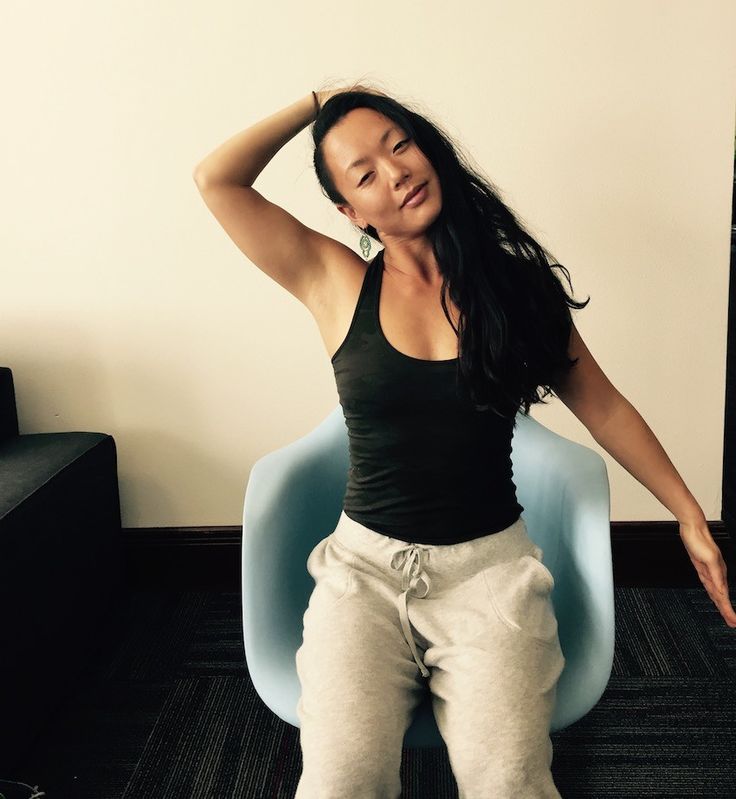
Take a moment to sit in Dandasana (Staff Pose): Come to a seated position on the floor with your legs extended in front of you; or sit in a chair, with your spine stacked over your hips and your knees bent, feet flat on the floor. Now, place both hands next to your hips, press your palms down into the ground or chair, take a deep inhale, and notice how you feel. Then, let your shoulders cave in toward your chest, and allow your head to come forward and chest to collapse. How do you feel now?
When I ask my patients to do this simple exercise, they report a marked difference in their mood when comparing sitting upright (they use adjectives like “alert,” “happy,” and “bright”) versus hunched over (which prompts reactions like “sad,” “tired,” and “negative”). It’s clear this kind of slumping can lead to energetic problems, but it can also cause biomechanical issues that trigger pain. And the worst part is, the vast majority of us tend to adopt this shoulders-hunched, neck-craned-forward posture regularly throughout our day thanks to our desk-bound jobs and affinity for mobile electronic devices.
The Anatomy Behind Slouched Posture
First, it’s important to look at the muscular imbalances this posture creates. In this position, the muscles that round your shoulders and internally rotate your upper arm bones (subscapularis, teres major, and anterior deltoids) shorten, causing a feeling of tightness. What’s more, the pectoralis major and minor (chest muscles that draw your arms and shoulders forward and together) as well as the levator scapulae, scalenes, sternocleidomastoid, and upper trapezius (muscles in the back and side of your neck that hold your head forward) get overworked, which also leads to tightness. And then there are the muscles that get turned “off” and weaken: the ones that externally rotate the upper arm bones (infraspinatus, teres minor, and posterior deltoids); those that stabilize the shoulder blades and draw them down the back (serratus anterior, rhomboids, middle and lower trapezius); and the cervical or deep neck flexors (longus capitis and longus colli).
This simultaneous over- and under-working of muscle groups leads to imbalances that affect the shoulder girdle. Over time, chronic slumping can cause rotator cuff problems, such as rotator cuff syndrome (in which the muscles and tendons of the shoulder get pinched and inflamed, causing pain), and possibly even a rotator cuff tear thanks to chronic irritation. Neck pain is another common side effect. Think about it: When your head juts forward as you stare at a screen, your neck muscles— specifically the levator scapulae and upper trapezius—have to contract to hold it up. As a result, the cervical flexors under the neck become tired and weak, causing yet another pain-inducing imbalance.
3 Ways to Use Yoga to Release Neck Tension
Whatever the root cause of your slumping, your yoga practice can help alleviate any resulting pain or dips in mood by bringing more balance to the muscles in your chest, upper back, and neck.
1. These poses are a great place to start: 4 Yoga Poses for Better Posture, Less Neck Pain
2. I’m a big fan of holding Staff Pose: Sit upright with your palms pressing into the ground beside your hips. Draw your shoulders toward your midline and then slightly down your back; press your palms firmly into the ground and attempt to drag them away from each other isometrically. By doing so, you engage the weakened lower and middle trapezius and rhomboids, and you stretch the tight pectorals.
3. Here’s one more simple exercise for relaxing neck and chest tightness: Interlace the fingers of both hands and place them palm-down on the top of your head, right in the center. Press your head up into your hands as you gently press your hands down into your head. Hold this dual-pressing action for a few seconds, release for a few seconds, and then repeat once. You should feel a straightening of the spine and a lightness that may make you smile.
As I’ve learned, the best way to find the most brightness and to counter the inevitable muscular imbalances that arise as we move through our lives is to take the time to understand the biomechanics of these imbalances. We do so by using our body and studying the energetic shifts the imbalances cause, which in turn helps us more readily and predictably access the proper corrective yoga postures. It’s my opinion that this is what yoga is really for.
From: Yoga Journal
